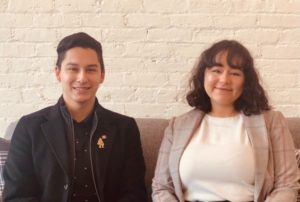Camosun second-year Business Administration student Josef Stafford is the co-creator of The Historical Natives, an online podcast all about Indigenous North American horror folklore. Along with co-host Mackenzie Taylor, Stafford explores different cryptids from across the continent.
“We tell the history, geography, and language of the specific peoples related to the creature we’re talking about,” says Stafford. “There’s the notable Wendigo and Sasquatch, of course, but there’s a lot more to be shared.”

Stafford and Taylor are both Ojibwe from Whitesand First Nations in Ontario, but they grew up on Vancouver Island. For The Historical Natives, Stafford handles the short stories, the website, and social media, while Taylor works on research, art, and editing and producing the podcast.
“Our inspiration for the podcast is, well, we both enjoy the horror genre and have for many years. We also really just wanted to do something that was close to our history,” says Stafford.
Taylor says that the podcast is a way for the two to help get back to their roots.
“We grew up kind of disconnected with our culture,” says Taylor, “and this is us finding a way to reconnect with it.”
The Historical Natives is a completely independent project that the duo has been interested in making for years.
“Around when the first Conjuring movie came out was when we were really introduced to horror,” says Stafford. “We’ve been thinking of doing a type of horror commentary podcast since about 2012, 2013.”
Taylor says that the two want people to learn and discover more about their culture.
“Dealing with the horror genre, we do kinda want the listener to be a little scared,” she says. “But we also have that history in there.”
Education is a huge part of The Historical Native’s mission, and the duo strives to teach their audience more about Indigenous stories, Indigenous language, and Indigenous culture.
“I definitely think stories are a huge part of who we are,” says Taylor. “We didn’t really know much about native folklore to begin with, so it’s also a learning experience for us.”
Stafford says that developing the podcast has also been an opportunity to grow his skill set.
“Every day we’re learning something new,” he says. “You can clearly see the difference from our first episode to our latest. We’re getting better with audio quality, how to edit, and how to make everything sound good.”
The podcast episodes start off with an introduction to the people, the traditions of those people, their history, and a “word of the week.” Once that’s done, the focus shifts to the creature the episode is based on. A short story about that creature, written by Stafford, is then read.
“[It’s] something to do that we enjoy doing,” says Stafford. “We’ve just been working at it every day whenever we have time.”
The two are currently producing an episode approximately every two weeks, but are hoping to do it weekly in the near future. Stafford says that it usually takes them a week and a half to do the research for an episode; being factual is important to them, so lots of time is spent fact-checking and cross-referencing between sources like Google and elders. The duo is also looking to expand their team in the future to include a researcher.
“[Research] is a very long and tedious process, but it needs to be done,” says Taylor. “We’d like to bring someone else on for the research so I can focus more on the art and producing the podcast.”
Episodes of The Historical Natives are available on Spotify, the Apple App Store or thehistoricalnatives.ca.
“Right now we’re still in the trial period—trying to figure out what works best for us to make the best of each episode,” says Stafford.
“But I can definitely see a long, prosperous future,” adds Taylor.

